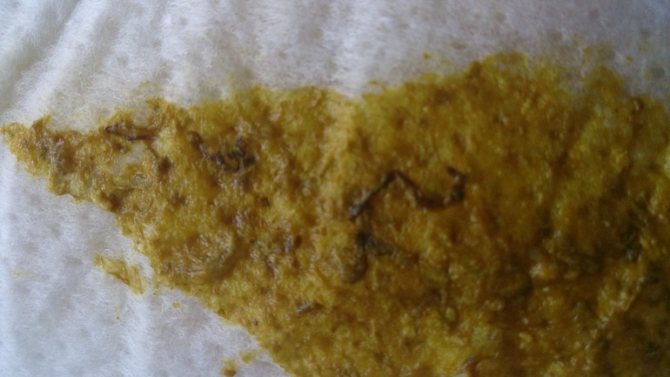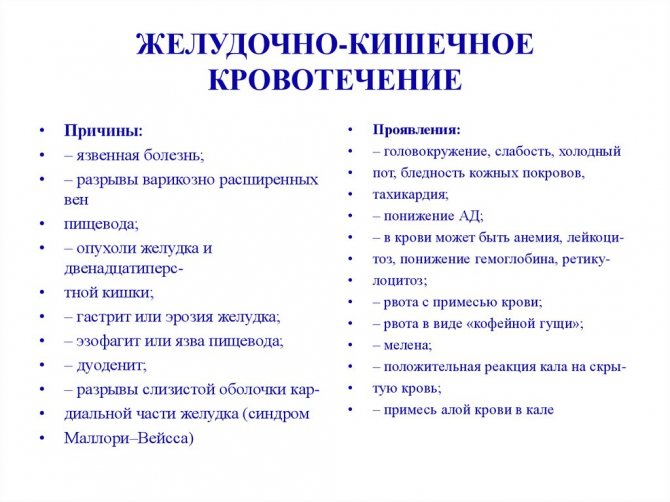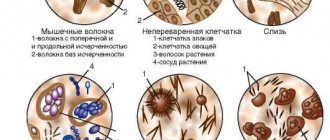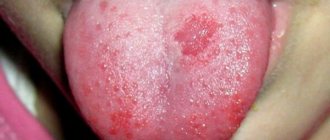The appearance of feces, their quantity, color and structure are very important characteristics from the point of view of diagnosing certain diseases in a child or confirming their absence. In particular, such observations make it possible to assess the condition and functioning of the gastrointestinal tract and draw conclusions about the presence of possible disorders. A cause for concern is often the appearance of unusual inclusions, streaks, or impurities in feces. Such symptoms indicate infectious and inflammatory processes in the digestive tract, pancreas, gall bladder or other organ that is involved in the digestion process. Obviously, the appearance of black strings in children's stool can cause concern for parents. However, should you worry about this?
Baby's stool is an important indicator of baby's health
Black strings in stool
In most cases, undigested or partially digested food resembles black threads. At first glance, these fragments closely resemble small black worms. In this case, there is no need to worry, since there is no talk of helminths here (worms are nothing more than iron compounds that have not been absorbed by the body).
In addition, black strings in a child’s stool can be the following items:
- Hair;
- Wool;
- Fabric pile.
This phenomenon is explained by the fact that in the first months and years of their lives, babies very actively study the world around them and literally try to taste all objects. Once in the mouth, various particles enter the child’s digestive tract, and then exit along with the feces in the form of various inclusions, including dark threads or sticks.
Advice. To prevent such manifestations, it is necessary to monitor what the baby puts into its mouth, and also try to keep the house as clean as possible.
Can strings be worms?
Worms (otherwise helminths) are parasitic worms, the vital activity of which can only be carried out inside the body of an animal or a person at the expense of the latter’s resources. Children are at risk of infection with helminths, since in childhood children do not follow the rules of hygiene well (or completely ignore them). Thus, worms very often cause gastrointestinal disorders, stunting and lack of weight, decreased protective functions of the body, etc. The most common sources of infection for a child are dirty vegetables and fruits, raw water, animals, and soil.
No matter how high the risk of infection with helminths is, black threads in a baby’s feces cannot turn out to be worms. The fact is that medicine has not yet identified black helminths.
On a note. In some cases, parasitic worms can turn dark in color under the influence of digested food, which contains coloring pigments.

Black strings in stool
Black spots in a child's stool
When establishing the causes of black feces, pediatricians rely on the age of the child. For a 1-3 week old newborn, feces with black spots are considered physiological norm. In fact, experts call the first bowel movements of babies not even feces, but meconium, for which the natural color is black or green.
The presence of mucus and white lumps in the feces of infants is also considered normal. The formation of digestion and a new diet transform meconium into normal stool, which has the usual light brown, yellow or white-yellow color.
How can a mother figure out why her tiny baby's stool is dark? Black stool in a breastfed baby under 12 months of age can occur when the mother eats iron-containing foods and takes certain medications. A change in the color of stool also occurs in a bottle-fed baby if the mother gives him a formula with a high iron content.
If black stool or mucus appears against the background of severe painful symptoms, the baby must be examined in a medical facility.
The reason for the appearance of strange lumps in the stool and its darkening can be various diseases, which are the task of the doctor to determine.
Diagnosis consists of an external examination of the child, tests, and a detailed medical history compiled based on the results of an interview with the parents.
Detecting the presence of a disease using tests is the task of a professional physician.
The identified trend is explained by the high content of iron in the listed vegetables and fruits, which gives the feces a black tint and causes the appearance of dark fibers, grains, villi and dots. Some medications can also affect color change:
- activated carbon tablets;
- vitamins with iron supplements (Vitrum);
- iron-containing products (for example, Sorbifer);
- preparations with bismuth (De-Nol).
Parents pay attention to any changes in the child’s body. Everyone knows that early diagnosis of pathologies is the key to quick and effective treatment.
Moms and dads monitor the appearance of the child, his skin and the nature of the discharge. It happens that a baby's urine or stool changes color.
Parents need to know why this happens and when to see a doctor.
The consistency of stool, its density and color change with the age of the baby. This is explained by the structure of the digestive system, the quality of digestion and metabolic processes, and also depends on the food eaten. The nature of the excrement can indicate the state of health, so it is important to monitor changes in the stool.
During intrauterine development, the baby's digestive system does not function. He receives all the substances necessary for growth through the umbilical cord. After birth, the work of the digestive organs begins.
In the first days of life, the stool of newborn children is a dark viscous mass - meconium. Its color varies from black to dark green.
The stool of a child under 6 months is a light-colored liquid paste. The excrement of breastfed babies and formula-fed babies differs.
Breast milk is completely suitable for feeding a newborn. It changes the composition depending on the needs of the baby. It is worth noting that white grains and lumps in the stool of a breastfed baby are not a cause for concern. It's just undigested milk fat.
Many mothers begin to worry when they see greenish foamy stools that look like diarrhea in their baby. In this case, it is necessary to reconsider the feeding technique.
The fact is that the so-called foremilk, located in the breast closer to the nipple, is more liquid and contains fewer nutrients. Hind milk is more nutritious and thick.
If hind milk remains in the breast after feeding, the baby should be placed on the same breast when feeding again. Receiving only foremilk causes the stool to turn green.
The feces of formula-fed babies are thicker and darker. After switching to regular food at the age of 2–3 years, children's feces take on the appearance of adult feces. The digestive organs begin to work at full capacity.
Black feces in a child are most often a reaction to food and medications. It is necessary to clarify what the baby ate in the previous 3 days and monitor feces in the near future. Food stays in the digestive system for about 2-3 days, so your baby may have black stool for several days after eating certain foods.
In a formula-fed infant, black or green stool may appear after the introduction of a formula with a high iron content. Once in the body, it oxidizes due to a reaction with gastric juice containing acid. As a result, the feces turn black.
If a child takes vitamin supplements with a high iron content or iron supplements, his stool will turn black. The body does not absorb the substance in full; after digestion is normalized, the coloring will stop. This phenomenon is not a pathology, so there is no need to exclude foods or interrupt treatment.
Activated carbon is a medicine used to improve digestion. It acts as a sorbent, absorbing toxins.
By absorbing a large amount of liquid, the tablets increase in volume, but their color does not change.
Activated carbon colors stool because it cannot be digested and does not enter the blood, but comes out, combining with feces. After stopping the intake, the color of the stool returns to normal.
Some medications can turn stool black. As a rule, the instructions for the product indicate in the side effects that the active substance changes the color of feces. These include:
- antibiotics (Flexid, Trichopolum);
- ibuprofen (Nurofen);
- paracetamol (Efferalgan, Panadol);
- bismuth-based preparations (Vicalin).
When mucus, black spots, strings or grains appear in the stool, parents begin to worry about the baby’s health. There are concerns associated with the presence of parasites in the body. Fears are completely groundless, since there are no worms that have such an appearance. Most often, changes are caused by consumed iron-based foods and medications.
The digestive system of children is not adapted to break down solid food. Introducing new complementary foods and eating berries and fruits that have seeds and grains contribute to the appearance of black dots, strings, lumps and specks in the excrement. For example, when eating a banana, black strings may appear in a baby's stool. This is due to the fruit's fiber-like texture.
Children actively explore the world around them and taste all objects. Keeping track of your baby's actions can be difficult.
Getting small pieces of fabric or pencils into the digestive system does not pose a danger, since the fragments are easily excreted undigested. As a rule, strings, sticks or dots appear.
It is necessary to ensure that the child does not put large objects into his mouth, as their entry into the respiratory tract can cause suffocation.
A change in the color of stool and the appearance of various inclusions and stripes in it may indicate the presence of diseases. In this case, the child develops other symptoms against the background of darkening of the feces.
In this case, it is necessary to seek help from a doctor in order to promptly diagnose the disorder and begin the necessary treatment.
Ignoring the signs can negatively impact your digestive system and overall health.
Gastrointestinal diseases
Symptoms of digestive diseases:
- colic and cramping in the abdomen;
- heat;
- flatulence;
- diarrhea interspersed;
- vomiting and regurgitation;
- lack or decreased appetite;
- weakness;
- feeling of discomfort in the anal area.
These symptoms appear with stomach and duodenal ulcers and other inflammations. It is necessary to consult a doctor to confirm or exclude the diagnosis.
The pancreas and liver produce enzymes that promote rapid digestion of food. The appearance of black stool with mucus may indicate cirrhosis or hepatitis. At the beginning of the disease, the feces are white, then become very dark. With pathology of the pancreas, there are inclusions in the stool, and the stool takes on a gray tint.
Internal bleeding occurs when the walls of the digestive organs are damaged. It can be caused by inflammatory processes or the entry of a foreign object.
The excrement turns black due to the specific effect of gastric juice on the blood. During the reaction, it oxidizes and the feces become dark in color.
If blood appears in the lower parts of the digestive system, it comes out unchanged, and the baby develops red stool.
The main indicator of unreasonable fear for health is the well-being of the baby. If the baby actively plays, sleeps and eats well, then all processes have physiological causes. If a child has peptic ulcers, you should show the baby to a doctor. Other symptoms requiring specialist consultation:
- excessive vomiting or regurgitation;
- diarrhea;
- high body temperature;
- lethargy and moodiness.
As a rule, we do not pay much attention to our own feces; we do not realize that its external state can tell a lot about our health. It is important to take into account the consistency and shade in order to understand what is happening to your organs. Black dots in stool are not considered normal and confirm certain disorders.
The color and consistency of stool vary depending on a person's age and diet. The shade will be light yellow or darkened with brown tones if there are no impurities, and this is considered normal. A biological mass containing white or dark spots becomes a cause for concern, but there is no need to panic.
What should normal stool look like in a newborn, infant, or preschooler?
During intrauterine development, the baby's digestive system does not function. He receives all the substances necessary for growth through the umbilical cord. After birth, the work of the digestive organs begins. In the first days of life, the stool of newborn children is a dark viscous mass - meconium.
Many mothers begin to worry when they see greenish foamy stools that look like diarrhea in their baby. In this case, it is necessary to reconsider the feeding technique. The fact is that the so-called foremilk, located in the breast closer to the nipple, is more liquid and contains fewer nutrients. Hind milk is more nutritious and thick.
Source: https://mst-life.ru/chernye-vkrapleniya-kale-rebenka/
Deviation or norm
Black grains in children's stool, similar to buckwheat, or threads in most cases are normal. In particular, this can happen if the child eats a sufficient amount of iron-rich foods.
Why does a child under one year old have abundant clear snot?
On a note. The recommended iron intake for a child is 7 to 11 mg per day.
In the first months of life, the baby’s body is not yet able to fully absorb some substances, including iron. Gradually, the child’s digestive system reaches the required level of development, and therefore the problem of undigested iron and the appearance of black “worms” in the feces disappears by itself.
Important! A deviation can be discussed if the baby does not consume iron-containing foods, but black stripes are still present in the stool. In this case, it is recommended to consult a doctor for advice and undergo the necessary tests. If, in addition to the indicated symptom, the child experiences a deterioration in health, then the presence of pathology leaves little doubt.
Causes of the phenomenon
Why do white lumps appear in baby's stool?
Why do black or brown fibers appear in my baby's stool? The formation of the intestines and other organs involved in the digestion of food in children occurs during the first three years of life. This period is characterized by various changes regarding the color and consistency of stool. Therefore, black inclusions in the stool of a baby, similar to worms, are most often explained by the underdevelopment of the digestive system of the young body. Thus, the cause is physiological in nature and does not require medical intervention.
According to Dr. Komarovsky, such manifestations may depend on the type of diet:
- Breastfeeding (breastfeeding);
- Artificial mixture (for example, Nutrilon Comfort);
- Mixed;
- Availability of complementary foods.
In some cases, pathological processes may occur in the child’s body, one of the signs of which is feces with small black inclusions in the baby, reminiscent of worms.
When not to worry
The digestive tract of a small child is not yet capable of digesting food “like an adult.” For this reason, some foods are only partially absorbed by the child’s body or are completely rejected, and as a result are excreted along with the feces.
Diarrhea with mucus in a child under one year old - why does a baby poop loosely?
The presence of dark “worms” in the stool of an infant or older child is a consequence of the use of:
- Apples, persimmons, bananas, pears, kiwis, pineapples, grapes, black currants, beets, broccoli, poppy seeds and other foods containing iron;
- Iron-containing vitamins and various medications.
On a note. The likelihood of black fluff appearing increases if the product was introduced into the child’s diet for the first time since birth. In older children, a similar symptom is observed if they eat large amounts of kiwi or persimmon. Undigested iron particles can come out not only in the form of black threads, but also tiny inclusions, resembling a poppy seed in shape and size.
If the baby is breastfed, the occurrence of such particles in the stool can be explained by the diet of the nursing mother. If a woman ate a large amount of bananas before lactation, then breast milk will absorb a significant amount of iron. As a result of feeding, the baby’s body receives a certain amount of this substance, but it is not yet able to digest even such a small amount.
Black feces in a newborn can be explained by the passage of meconium in the baby in the first days of his life. Original feces are colored black-green. As the child's intestines are cleared of meconium, the color of the stool changes, but black spots may remain for some time.
On a note. If the cause of the appearance of strings is related to the diet of the child or his mother, there is no need to limit the consumption of iron-containing products, since this symptom does not pose a danger to the baby’s health.
Another harmless cause is the child swallowing hair and other foreign objects. Children aged 4-5 months actively taste the things around them, so they can easily swallow their own hair, a piece of dog hair, etc.
In addition to iron-containing foods, children's intestines have difficulty digesting carrots. Pieces of the vegetable may come out along with the feces and resemble dark threads.
Dark “worms” often appear as a result of taking certain medications, the remains of which are excreted from the body along with feces. So, threads appear after taking the following medications:
- Sorbents (for example, activated carbon);
- Vitamins in combination with various microelements;
- Drugs whose action is aimed at increasing hemoglobin in the blood.
Most often, after taking sorbents, the stool turns completely black. This effect is natural, since this type of medicine cleanses the body of waste and toxins, along with which it comes out in the form of black feces. Thus, you should not refuse to take medications for this reason.
In some cases, children are prescribed bacteria to form intestinal microflora (for example, bifidumbacterin). As a result of this therapy, black “worms” may appear in the stool (as a result of establishing a bacterial balance).
Quite often, young children suffer from anemia (anemia), which is caused by a low level of hemoglobin in the blood. To replenish the missing element, the child is prescribed a course of taking iron in the form of tablets or syrup. Since the substance is poorly digested by the children's intestines, some of the iron comes out along with the feces in the form of black lumps.

Iron-containing foods often cause black threads to appear in a child’s stool.
Causes of black streaks and specks in a newborn’s stool
The appearance of feces, their quantity, color and structure are very important characteristics from the point of view of diagnosing certain diseases in a child or confirming their absence. In particular, such observations make it possible to assess the condition and functioning of the gastrointestinal tract and draw conclusions about the presence of possible disorders.
A cause for concern is often the appearance of unusual inclusions, streaks, or impurities in feces. Such symptoms indicate infectious and inflammatory processes in the digestive tract, pancreas, gall bladder or other organ that is involved in the digestion process.
Obviously, the appearance of black strings in children's stool can cause concern for parents. However, should you worry about this?
Baby's stool is an important indicator of baby's health
Black strings in stool
In most cases, undigested or partially digested food resembles black threads. At first glance, these fragments closely resemble small black worms. In this case, there is no need to worry, since there is no talk of helminths here (worms are nothing more than iron compounds that have not been absorbed by the body).
In addition, black strings in a child’s stool can be the following items:
- Hair;
- Wool;
- Fabric pile.
This phenomenon is explained by the fact that in the first months and years of their lives, babies very actively study the world around them and literally try to taste all objects. Once in the mouth, various particles enter the child’s digestive tract, and then exit along with the feces in the form of various inclusions, including dark threads or sticks.
Advice. To prevent such manifestations, it is necessary to monitor what the baby puts into its mouth, and also try to keep the house as clean as possible.
Can strings be worms?
Worms (otherwise helminths) are parasitic worms, the vital activity of which can only be carried out inside the body of an animal or a person at the expense of the latter’s resources.
Children are at risk of infection with helminths, since in childhood children do not follow the rules of hygiene well (or completely ignore them).
Thus, worms very often cause gastrointestinal disorders, stunting and lack of weight, decreased protective functions of the body, etc. The most common sources of infection for a child are dirty vegetables and fruits, raw water, animals, and soil.
No matter how high the risk of infection with helminths is, black threads in a baby’s feces cannot turn out to be worms. The fact is that medicine has not yet identified black helminths.
On a note. In some cases, parasitic worms can turn dark in color under the influence of digested food, which contains coloring pigments.
Black strings in stool
Deviation or norm
Black grains in children's stool, similar to buckwheat, or threads in most cases are normal. In particular, this can happen if the child eats a sufficient amount of iron-rich foods.
Why does a child under one year old have abundant clear snot?
On a note. The recommended iron intake for a child is 7 to 11 mg per day.
In the first months of life, the baby’s body is not yet able to fully absorb some substances, including iron. Gradually, the child’s digestive system reaches the required level of development, and therefore the problem of undigested iron and the appearance of black “worms” in the feces disappears by itself.
Important! A deviation can be discussed if the baby does not consume iron-containing foods, but black stripes are still present in the stool.
In this case, it is recommended to consult a doctor for advice and undergo the necessary tests.
If, in addition to the indicated symptom, the child experiences a deterioration in health, then the presence of pathology leaves little doubt.
Causes of the phenomenon
Why do white lumps appear in baby's stool?
Why do black or brown fibers appear in my baby's stool? The formation of the intestines and other organs involved in the digestion of food in children occurs during the first three years of life.
This period is characterized by various changes regarding the color and consistency of stool. Therefore, black inclusions in the stool of a baby, similar to worms, are most often explained by the underdevelopment of the digestive system of the young body.
Thus, the cause is physiological in nature and does not require medical intervention.
According to Dr. Komarovsky, such manifestations may depend on the type of diet:
- Breastfeeding (breastfeeding);
- Artificial mixture (for example, Nutrilon Comfort);
- Mixed;
- Availability of complementary foods.
In some cases, pathological processes may occur in the child’s body, one of the signs of which is feces with small black inclusions in the baby, reminiscent of worms.
When not to worry
The digestive tract of a small child is not yet capable of digesting food “like an adult.” For this reason, some foods are only partially absorbed by the child’s body or are completely rejected, and as a result are excreted along with the feces.
Diarrhea with mucus in a child under one year old - why does a baby poop loosely?
The presence of dark “worms” in the stool of an infant or older child is a consequence of the use of:
- Apples, persimmons, bananas, pears, kiwis, pineapples, grapes, black currants, beets, broccoli, poppy seeds and other foods containing iron;
- Iron-containing vitamins and various medications.
On a note. The likelihood of black fluff appearing increases if the product was introduced into the child’s diet for the first time since birth.
In older children, a similar symptom is observed if they eat large amounts of kiwi or persimmon.
Undigested iron particles can come out not only in the form of black threads, but also tiny inclusions, resembling a poppy seed in shape and size.
If the baby is breastfed, the occurrence of such particles in the stool can be explained by the diet of the nursing mother.
If a woman ate a large amount of bananas before lactation, then breast milk will absorb a significant amount of iron.
As a result of feeding, the baby’s body receives a certain amount of this substance, but it is not yet able to digest even such a small amount.
Black feces in a newborn can be explained by the passage of meconium in the baby in the first days of his life. Original feces are colored black-green. As the child's intestines are cleared of meconium, the color of the stool changes, but black spots may remain for some time.
On a note. If the cause of the appearance of strings is related to the diet of the child or his mother, there is no need to limit the consumption of iron-containing products, since this symptom does not pose a danger to the baby’s health.
Another harmless cause is the child swallowing hair and other foreign objects. Children aged 4-5 months actively taste the things around them, so they can easily swallow their own hair, a piece of dog hair, etc.
In addition to iron-containing foods, children's intestines have difficulty digesting carrots. Pieces of the vegetable may come out along with the feces and resemble dark threads.
Dark “worms” often appear as a result of taking certain medications, the remains of which are excreted from the body along with feces. So, threads appear after taking the following medications:
- Sorbents (for example, activated carbon);
- Vitamins in combination with various microelements;
- Drugs whose action is aimed at increasing hemoglobin in the blood.
Most often, after taking sorbents, the stool turns completely black. This effect is natural, since this type of medicine cleanses the body of waste and toxins, along with which it comes out in the form of black feces. Thus, you should not refuse to take medications for this reason.
In some cases, children are prescribed bacteria to form intestinal microflora (for example, bifidumbacterin). As a result of this therapy, black “worms” may appear in the stool (as a result of establishing a bacterial balance).
Quite often, young children suffer from anemia (anemia), which is caused by a low level of hemoglobin in the blood. To replenish the missing element, the child is prescribed a course of taking iron in the form of tablets or syrup. Since the substance is poorly digested by the children's intestines, some of the iron comes out along with the feces in the form of black lumps.
Iron-containing foods often cause black threads to appear in a child’s stool.
What should parents worry about?
If, in addition to the presence of dark spots in the stool, the child exhibits additional symptoms, the baby should be shown to a specialist. Dangerous signs in this case are:
- Increased body temperature;
- Fever;
- Nausea, vomiting;
- Abnormal stool (diarrhea, constipation, alternating first and last);
- Flatulence, colic;
- Skin rashes, red spots;
- Tearfulness, constant whims, anxiety;
- Poor sleep;
- Weight loss;
- Lack of appetite;
- Cramping pain in the abdominal area;
- Itching in the anal area;
- Itching in the neck, face, abdomen;
- Rumbling in the stomach immediately after eating or between feedings;
- Headache;
- Decreased immunity (the baby often suffers from colds);
- Deterioration in general health;
The reasons for such manifestations may be:
- The body’s inability to properly absorb certain foods;
- Allergy;
- Error in feeding;
- Postoperative period. In this case, a change in the color of the stool may be a symptom of internal bleeding in the organs of the digestive system. With intense blood secretion, the latter accumulates in the stomach, coagulates, then ends up in the intestines and is excreted along with feces, forming a sticky, dark, thick mass.
If there is internal bleeding at an early stage, small dark streaks may appear in the stool. If you notice this symptom, you should consult a doctor as soon as possible. Most often, the child has no additional symptoms, but the baby’s general condition quickly deteriorates, and not only his health, but also his life is threatened.
Signs of severe internal bleeding include bloody vomiting and progressive weakness syndrome. In this case, the body temperature rises to 38.5 degrees, severe cramps in the abdominal area, vomiting, and upset stool occur.
Causes and symptoms of intestinal bleeding
A medical examination is also necessary if black threads or black dots appear regularly in a child’s stool (even if no other negative signs are observed). This sign indicates a digestive disorder, which can be caused by gastrointestinal pathology.
How to make a diagnosis
If there are complaints, the doctor prescribes an appropriate examination. To determine the cause of the appearance of black threads in the stool, it is necessary to conduct laboratory diagnostics. If there are serious symptoms (pallor of the skin, mucous membranes, severe cramping pain in the lower abdomen, apathetic syndrome), a comprehensive examination is carried out, which includes:
- X-ray;
- Coprogram;
- Ultrasound;
- Coagulogram.
When contacting a pediatrician, the doctor performs a physical examination of the child and studies tests.
So, black threads in a child’s stool are usually not a sign of a dangerous disease. This symptom is natural. However, in some cases, dark specks in the stool indicate internal pathology. To understand whether a symptom poses a danger to the baby, you need to pay attention to the child’s general condition.
Source: https://kpoxa.info/zdorovie-pitanie/chernye-nitochki-kale-rebenka.html
What should parents worry about?
If, in addition to the presence of dark spots in the stool, the child exhibits additional symptoms, the baby should be shown to a specialist. Dangerous signs in this case are:
- Increased body temperature;
- Fever;
- Nausea, vomiting;
- Abnormal stool (diarrhea, constipation, alternating first and last);
- Flatulence, colic;
- Skin rashes, red spots;
- Tearfulness, constant whims, anxiety;
- Poor sleep;
- Weight loss;
- Lack of appetite;
- Cramping pain in the abdominal area;
- Itching in the anal area;
- Itching in the neck, face, abdomen;
- Rumbling in the stomach immediately after eating or between feedings;
- Headache;
- Decreased immunity (the baby often suffers from colds);
- Deterioration in general health;
The reasons for such manifestations may be:
- The body’s inability to properly absorb certain foods;
- Allergy;
- Error in feeding;
- Postoperative period. In this case, a change in the color of the stool may be a symptom of internal bleeding in the organs of the digestive system. With intense blood secretion, the latter accumulates in the stomach, coagulates, then ends up in the intestines and is excreted along with feces, forming a sticky, dark, thick mass.
If there is internal bleeding at an early stage, small dark streaks may appear in the stool. If you notice this symptom, you should consult a doctor as soon as possible. Most often, the child has no additional symptoms, but the baby’s general condition quickly deteriorates, and not only his health, but also his life is threatened.
Signs of severe internal bleeding include bloody vomiting and progressive weakness syndrome. In this case, the body temperature rises to 38.5 degrees, severe cramps in the abdominal area, vomiting, and upset stool occur.

Causes and symptoms of intestinal bleeding
A medical examination is also necessary if black threads or black dots appear regularly in a child’s stool (even if no other negative signs are observed). This sign indicates a digestive disorder, which can be caused by gastrointestinal pathology.
Causes of bowel dysfunction in infants
The reasons for the appearance of blood in the stool may not be immediately established. In some cases, bleeding is caused by serious dysfunction of internal organs. The examination requires an integrated approach.
Black spots
The appearance of small dark dots or black threads in a baby is usually observed on the third day of his life. The phenomenon is explained by the emptying of the stomach from original feces - meconium. It has a viscous and sticky consistency. Original feces contain digested baby hair, amniotic fluid, mucus, epithelial cells, as well as a small amount of lactobacilli, which produce lactic acid and participate in the formation of fetal immunity.
In most cases, feces with dark spots do not signal any pathology. If parents notice inclusions of black threads, then it is necessary to monitor the baby’s nutrition and behavior. Often, when getting acquainted with the outside world, a child puts various foreign objects in his mouth. Ingestion of fur, dust and hair can cause not only black stools, but also dyspepsia, which is characterized by bloating.
From the age of six months, fruits and vegetables are added to the diet, which change the color of the stool. For example, a child may develop black threads after eating bananas. This is due to the lack of necessary enzymes when digesting this product. By the age of one year, the stool is formed, acquiring a natural brown color and uniform consistency.
If loose stools with black threads appear, you should urgently call an ambulance.
This condition may indicate internal bleeding in one of the parts of the gastrointestinal tract. Stomach ulcers, colitis, and varicose veins of the digestive system can also be a provocateur.
Red veins
Streaks of blood in the stool of a baby may appear regardless of the nature of the diet. If blood or bloody streaks resembling snot are found in the stool, then this symptom may indicate certain diseases.
The following reasons can be identified:
- Constipation.
- Sores around mother's nipples. When breastfeeding, the baby swallows the blood released from the nipples.
- Wounds and cracks in the baby's anus.
- Atopic dermatitis. With this pathology, the intestinal mucosa becomes covered in a rash and bleeds.
- Imbalance of intestinal microflora. Bloody mucus will be released in the stool.
- An allergic reaction to the protein contained in milk. In this case, stool disturbance is accompanied by vomiting. Protein can enter a child's body through formula or from breast milk. Usually there is peeling, rash and redness. The child's appetite decreases. This condition causes anemia.
- Inflammatory processes in the intestines. In this case, blood clots do not mix with feces, and the stool acquires a liquid consistency. The child has vomiting and loss of appetite.
- Intestinal infection. Body temperature rises.
- Pathological processes in various parts of the intestine. There is an increase in temperature and a decrease in appetite. The child is bothered by pain in the abdominal area.
- Low levels of vitamin K, which is responsible for blood clotting.
- Damage to the body by helminths. In addition to spotting, there is weight loss and rashes on the body.
- Polyps in the intestines. This condition is accompanied by bleeding. Sometimes blood is not released with the stool. It is detected during testing.
- Lactose deficiency. The child's body contains the enzyme in small quantities. An admixture of blood and mucus, as well as lumps of milk, is found in the stool. The child becomes capricious and lethargic.
How to make a diagnosis
If there are complaints, the doctor prescribes an appropriate examination. To determine the cause of the appearance of black threads in the stool, it is necessary to conduct laboratory diagnostics. If there are serious symptoms (pallor of the skin, mucous membranes, severe cramping pain in the lower abdomen, apathetic syndrome), a comprehensive examination is carried out, which includes:
- X-ray;
- Coprogram;
- Ultrasound;
- Coagulogram.
When contacting a pediatrician, the doctor performs a physical examination of the child and studies tests.
So, black threads in a child’s stool are usually not a sign of a dangerous disease. This symptom is natural. However, in some cases, dark specks in the stool indicate internal pathology. To understand whether a symptom poses a danger to the baby, you need to pay attention to the child’s general condition.











